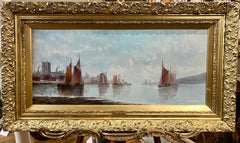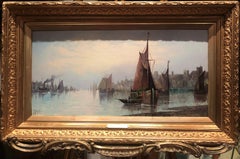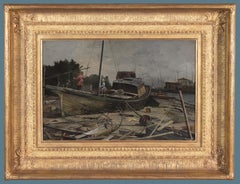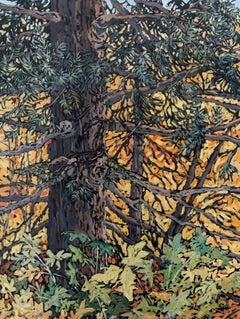John Edward Bale Art
to
1
1
Overall Width
to
Overall Height
to
2
2
2
2
1
2
2
2
8,227
2,805
1,656
1,313
2
2
Artist: John Edward Bale
HUGE OIL PAINTING By MAJOR John E .Bale FINE MASTER 19th Century BRITISH SCHOOL
By John Edward Bale
Located in Ferndown, GB
OIL PAINTING SIGNED OLD FINE MASTER PAINTER 19th Century BRITISH SCHOOL
Fine Original Antique 19th Century British OLD MASTER
OIL PAINTING
GOLD GILT FRAME
NEW COLLECTION Of RARE ...
Category
Late 19th Century Realist John Edward Bale Art
Materials
Oil
OIL PAINTING By MAJOR John E . Bale OLD FINE MASTER 19th Century BRITISH SCHOOL
By John Edward Bale
Located in Ferndown, GB
OIL PAINTING SIGNED OLD FINE MASTER PAINTER 19th Century BRITISH SCHOOL
Fine Original Antique 19th Century British OLD MASTER
OIL PAINTING
GOLD GILT FRAME
NEW COLLECTION Of RARE PIECES OF ENGLISH HISTORY
By Major John Edward Bale Similar $5,000 Premier Collection
Excellent Condition Panel, Professional Cleaned & re-varnished
Ready to hang.
frame is in wonderful condition .
( note all this would cost £600 alone)
John Edward Bale, was born at Low Farm House, Pattesley-cum-Oxwick,
South Creake, Norfolk on 27 July and baptised at South Creake on
1 August 1834, eldest child of John Edward Bale (1803-27 April 1862),
a farmer of 620 acres, and his wife Mary née Branford,
who married at Horningtoft, Norfolk on 27 November 1833. In 1841,
a 6 year old, living at Low Farm with his parents, 35 year old John and
28 year old Mary, and his two sisters, Mary 3 and Esther 1. In 1861,
a 26 year old 'artist architecture' boarding at 11 Bulstrode Street,
Marylebone, London but in October 1863, he was an Ensign by purchase
in the 1st West Indian Regiment. As a lieutenant, whilst on a tour of
duty in West Africa, Surgeon Major Augustus Frederick Elliott (born 1834),
kept a diary (now at Duke University Library) which is embellished with
calligraphy and watercolour titles by Bale. During this tour, Bale was
promoted to Captain and retired from the army in 1881 with the rank of major.
Bale married at Christ Church, Ealing on 10 November 1868,
Charlotte Gordon Lee née Johnson (c1847-1910).
A painter in oil and watercolour and a member of the Ipswich
Fine Art Club 1886-1890 and as Major Bale exhibited from 9 Creffield Terrace,
Colchester, Essex in 1888, 'View from Museum...
Category
Late 19th Century Realist John Edward Bale Art
Materials
Oil
Related Items
Children Playing on a Boat, likely New York/Brooklyn/Flatbush Area, c. 1895
Located in Philadelphia, PA
Charles Lewis Fussell
(American, 1840–1909)
Children Playing on a Boat
Oil on canvas, 11 x 16 3/4 inches
Framed: 19 x 25 inches (approx.)
Signed at lower left: “C.L. Fussell”
Charle...
Category
1890s Realist John Edward Bale Art
Materials
Canvas, Oil
Celebrating Autumn With the Mother Tree, Original Oil Painting
By Deb Komitor
Located in Denver, CO
"Celebrating Autumn With the Mother Tree" by Deb Komitor (United States) is a handmade landscape oil painting that is framed and ready to hang.
Deb Komitor, born in 1957, is a conte...
Category
21st Century and Contemporary Realist John Edward Bale Art
Materials
Oil
$4,200
H 40 in W 30 in D 1.5 in
Pastoral Landscape Meeting on Bridge Early 19th century Oil Painting on Canvas
Located in Stockholm, SE
Summer rustic scene depicts an idyllic picture of country life in which harmony and happiness reign. The muted, slightly blurry colors convey the artist's inner world and mood, while...
Category
Early 19th Century Realist John Edward Bale Art
Materials
Canvas, Wood, Oil
$680
H 21.1 in W 27.2 in
“LABERINTOS DE SILENCIO“. Contemporary, realism, figurative, oil, landscape, wat
Located in MADRID, ES
Contemporary, realism, figurative, oil, landscapa, waterscape, pastel colors, earth colors
Category
2010s Realist John Edward Bale Art
Materials
Wood, Oil
$2,329
H 28.75 in W 28.75 in
Barbizon School, Fontainebleau landscape with walkers, oil on canvas
Located in Paris, FR
Barbizon School, French circa 1850
Fontainebleau landscape with walkers
Oil on canvas
21.5 x 31 cm
Framed : 32 x 41.5 cm
In good condition, some minor lacks of paintingsdue to a former frame abrasion mainly on the right border and in the lower border (see photographs please)
This landscape is probably a view of the Fontainebleau forest. This type of scene was painted by the Barbizon painters and by Camille Corot.
The village of Barbizon is very close to the forest of Fontainebleau and the painters who lived there, such as Camille Corot, painted the most picturesque views of the spectacular stone quarries. There were also many walkers and hikers in these places, as the artists had made them famous and fashionable.
The author of this charming little painting wanted to depict the wildness of the place and, in contrast, the walkers who made it a pittoresque curiosity.
Although it's difficult to identify or ascribe the work, as there's no signature or other indication, there's a great deal of sensitivity and self-confidence in a very lively touch that heralds Impressionism.
The detail of the barely sketched silhouettes...
Category
1850s Realist John Edward Bale Art
Materials
Oil
$1,762
H 8.47 in W 12.21 in
Crossing the ford Capriccio Baroque Landscape 18th century Oil Painting
Located in Stockholm, SE
As we gaze upon at this artwork, our eyes are immediately drawn to the foreground where a comical spectacle unfolds before us. A carriage, stubbornly stuck in the midst of a ford, se...
Category
Late 18th Century Realist John Edward Bale Art
Materials
Canvas, Wood, Cotton Canvas, Oil
“ESTERO“. Contemporary, realism, figurative, oil, landscape, waterscape, earth c
Located in MADRID, ES
Contemporary, realism, figurative, oil, landscapa, waterscape, pastel colors, earth colors
Category
2010s Realist John Edward Bale Art
Materials
Wood, Oil, Acrylic
$4,479
H 45.67 in W 45.67 in
"Universo vegetal", Realism, figurative, flowers, bright colors
Located in MADRID, ES
Realism, figurative, flowers, bright colors
Category
2010s Realist John Edward Bale Art
Materials
Canvas, Oil
$4,778 Sale Price
20% Off
H 47.25 in W 47.25 in D 1.97 in
"I had a dream last night" Oil Painting 24" x 28 "inch by Dmitriy Krestniy
By Dmitriy Krestniy
Located in Culver City, CA
"I had a dream last night" Oil Painting 24" x 28 "inch by Dmitriy Krestniy
2007
Comes in a custom frame
Size with frame: 26" x 30"
A look through Dmi...
Category
21st Century and Contemporary Realist John Edward Bale Art
Materials
Canvas, Oil
$3,500
H 24 in W 28 in D 1 in
“LAGUNA LA INESPERADA “. Contemporary, realism, figurative, oil, landscape, wate
Located in MADRID, ES
Contemporary, realism, figurative, oil, landscapa, waterscape, pastel colors, earth colors
Category
2010s Realist John Edward Bale Art
Materials
Wood, Oil
$2,329
H 23.63 in W 39.38 in
“MARISMA DORADA“. Contemporary, realism, figurative, oil, landscape, waterscape
Located in MADRID, ES
Contemporary, realism, figurative, oil, landscapa, waterscape, pastel colors, earth colors
Category
2010s Realist John Edward Bale Art
Materials
Wood, Oil, Acrylic
$4,479
H 45.67 in W 45.67 in
“MARISMA“. Contemporary, realism, figurative, oil, landscape, waterscape, earth
Located in MADRID, ES
Contemporary, realism, figurative, oil, landscapa, waterscape, pastel colors, earth colors
Category
2010s Realist John Edward Bale Art
Materials
Wood, Oil, Acrylic
$4,479
H 45.67 in W 45.67 in
John Edward Bale art for sale on 1stDibs.
Find a wide variety of authentic John Edward Bale art available for sale on 1stDibs. You can also browse by medium to find art by John Edward Bale in oil paint, paint and more. Not every interior allows for large John Edward Bale art, so small editions measuring 19 inches across are available. Customers who are interested in this artist might also find the work of Andrew Grant Kurtis, Constance Anne Parker, and Jo Beer. John Edward Bale art prices can differ depending upon medium, time period and other attributes. On 1stDibs, the price for these items starts at $2,558 and tops out at $2,558, while the average work can sell for $2,558.



